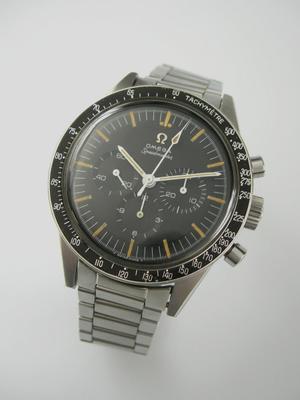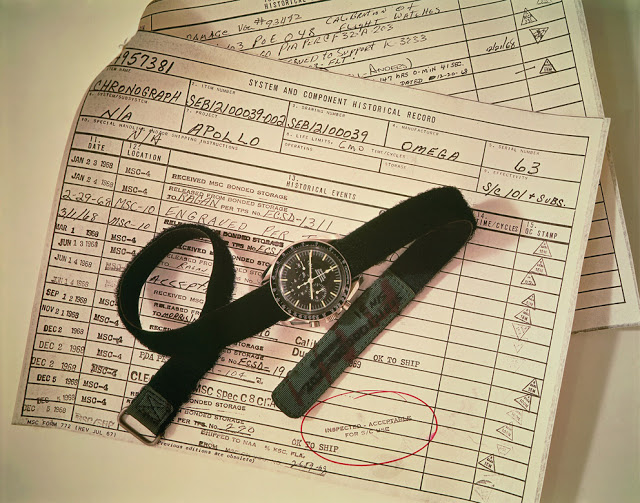Omega Speedmaster 1963-68
Omega Speedmaster 1957-1963
Omega Speedmaster 1963-68

With reference ST 105.002 in 1962 and reference ST 105.003 in 1963, Omega introduced the Speedmaster's typical straight baton hands.
That same year - with reference ST 105.012 - a 42 mm asymmetrical case, adding protection to the chronograph pushers and crown, was released. This is the case that remains, little changed, in production today. The Professional marking appeared below the Speedmaster logo on dial during summer 1965.
These were the years of the first manned space missions.
The solo-flight Mercury space programme was almost completed (the astronaut Wally Schirra had worn his own Speedmaster ref. CK 2998 on his Mercury flight on the 3rd of October, 1962) and NASA was preparing for the Gemini (two-man) and Apollo (three-man) missions. The astronauts on these missions were expected to move about in space outside the ship so they needed a wristwatch which could withstand the difficult conditions of space.
Beginning in about 1962, NASA purchased a series of chronographs of different brands, including Longines, Rolex and Omega, with the task of finding the best watch available for their astronauts to wear in space.
When NASA received the watches, they were subjected to a series of tests and pre-selection processes called the “Qualification Test Procedures”. Only three watches out of six chronographs successfully survived this arduous pre-selection phase. The finalists were then subjected to 11 different tests - the most rigorous trials endured in the history of horology: 1. High temperature: 48 hours at a temperature of 160°F (71°C) followed by 30 minutes at 200°F (93°C). 2. Low temperature: 4 hours at a temperature of 0°F (-18°C). 3. Temperature-Pressure: 15 cycles of heating to 71°C for 45 minutes, followed by cooling to -18°C for 45 minutes at 10−6 atm. 4. Relative humidity: 240 hours at temperatures varying between 68°F and 160°F (20°C and 71°C) in a relative humidity of at least 95%. 5. Oxygen atmosphere: 48 hours in an atmosphere of 100% oxygen at a pressure of 0.35 atm. 6. Shock: Six shocks of 40 G, each 11 milliseconds in duration, in six different directions. 7. Acceleration: From 1 G to 7.25 G within 333 seconds, along an axis parallel to the longitudinal spacecraft axis. 8. Decompression: 90 minutes in a vacuum of 10-6 atm at a temperature of 160°F (71°C) and 30 minutes at 200°F (93°C). 9. High pressure: 1.6 atm for a minimum period of one hour. 10. Vibration: Three cycles of 30 minutes vibration varying from 5 to 2000 Hz. 11. Acoustic noise: 130 db over a frequency range of 40 to 10,000 Hz, duration 30 minutes.
On March 1, 1965, the test results were completed and only the Omega Speedmaster passed. At the time, NASA’s testers wrote, "Operational and environmental tests of the three selected chronographs have been completed; and, as a result of the test, Omega chronographs have been calibrated and issued to three members of the Gemini Titan III crews."
James Ragan, the NASA engineer responsible for the qualification tests, has spoken about the importance of the Speedmaster by saying, “The watch was a backup. If the astronauts lost the capability of talking to the ground, or the capability of their digital timers on the lunar surface, then the only thing they had to rely on was the Omega watch they had on their wrist. It needed to be there for them if they had a problem.”
Curiously, Omega only learned about the Speedmaster’s journey into space after seeing a photograph of Ed White taken during America’s first spacewalk as part of the Gemini 4 mission in June of 1965. The watch was attached to the arm via a long nylon strap secured with Velcro.
Following the discovery, Omega decided to add the word "Professional" to the product name, thus becoming Omega Speedmaster Professional. The new reference number was 145.012
Omega Speedmaster Professional 1969-1978
Omega Speedmaster Mark III - ST176.002
Speedmaster Mark IV - ST176.009
Omega Speedmaster Professional 1979-1995
Omega Speedmaster Professional ST145.022
Omega Professional Mark II - ST145.014
Omega Speedmaster Mark III - ST176.002
Omega Speedmaster Mark IV - ST176.009
Omega Speedmaster Professional Mark 4.5 - ST176.0012

